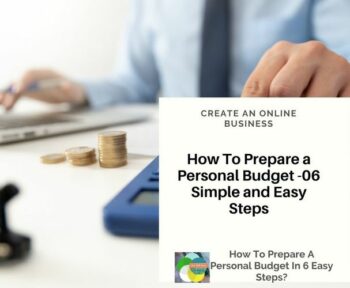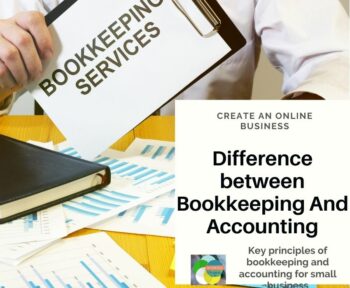You’ll need a budget if you want to keep track of your spending and achieve your financial goals. A personal or household budget is a summary of your income and expenses for a specific time period, usually, one month While the word “budget” conjures up images of controlled expenditure, it is not necessary for a budget to be efficient. This article provides an important guideline on how to prepare a personal budget with 6 steps.
A budget will show you how much money you plan to receive in, as well as your mandatory expenses (like rent and insurance) and discretionary spending (like entertainment or eating out). Rather than seeing a budget as a hindrance, think of it as a tool for accomplishing your financial objectives.
What is the Budget?
A monthly budget is a written financial planning tool that allows you to plan how much money you’ll spend or save each month. You can also keep track of your spending patterns.
Making a budget may not sound like the most thrilling activity (and it is for some), but it is an essential element of keeping your financial house in order.
Because budgets are based on balance, this is the case. Spending less in one area allows you to spend more in another, save for a significant purchase, develop a “rainy day” fund, boost your savings, or participate in wealth creation.
Finally, the outcome of your new budget will reveal where your money comes from, how much you have, and where it all goes each month.

Six Steps on How To Prepare Personal Budget
You must first determine what you are already spending, what you can afford to spend, and what your goals are in order to develop a budget that works for you and allows you to live a comfortable and happy life. Find a solid template to fill in the data for your costs and income before you start building a budget.
Step #01. Prepare Your Financial Paperwork
Gather all of your financial statements before you begin, including:
- Bank statements
- Investment accounts
- Recent utility bills
- Credit card bills
- Receipts from the last three months
- Mortgage or auto loan statements
You want to be able to see all of your revenue and expense records. Creating a monthly average is one of the most important aspects of the budgeting process. The more data you can get, the better.
Step #02. Calculate Your Income
What kind of monthly revenue can you expect? Using the net income (or take-home pay) figure is OK if your income is in the form of a regular paycheck with taxes deducted automatically. Include any outside sources of income, such as child support or Social Security, if you are self-employed.
Make a monthly total income of your total revenue.
Step #03. Make A List Of Your Monthly Expenses.
Make a list of all the expenses you intend to incur over the course of a month. This list could include the following items:
- Mortgage payments or rent
- Car payments
- Insurance
- Groceries
- Utilities
- Entertainment
- Personal care
- Eating out
- Childcare
- Transportation costs
- Travel
- Student loans
- Savings
To track your expenditure, go through your bank statements, receipts, and credit card statements from the previous three months.
Step #04. Calculate Fixed and Variable Costs
Fixed expenses are those that must be paid on a regular basis and for which you pay the same amount each time. Include payments for a house or rent, a car, a fixed-fee internet connection, trash pickup, and regular childcare.
Include any additional important spending that tends to stay the same from month to month if you pay a standard credit card payment. Include savings and debt repayment as fixed expenses if you plan to save a set amount or pay off a set amount of debt each month. Variable expenses are those that vary from month to month, for example:
- Groceries
- Gasoline
- Entertainment
- Eating out
- Gifts
Beginning with your fixed expenses, assign a spending value to each category. Then figure out how much you’ll need to spend on variable expenses each month.
If you’re not sure how much you spend in each category, look over your credit card or bank statements from the last two or three months to get an idea.
Step #05. Calculate Your Total Monthly Earnings And Expenses.
You’re on the right track if your revenue exceeds your costs. This extra cash allows you to allocate monies to other areas of your budget, such as retirement savings or debt repayment. If your expenses exceed your income, you’re overpaying and need to make some adjustments.

Step #06. Do Adjustment to Expenses
Find areas in your variable expenses where you can cut if your expenses are larger than your income. Look for ways to cut costs, such as dining out less, or eliminate a category, such as canceling your gym membership.
Aim for a balance in your revenue and expense columns. This equal balance indicates that all of your earnings have been accounted for and allocated to a specified cost or savings goal.
What is the Way of Use Your Budget?
You must monitor and continue to track your expenses in each category after you have set up your budget, ideally every day of the month. The same spreadsheet or tool that you used to create your budget can also be used to keep track of your expenses and revenue.
Keeping track of your spending throughout the month will help you avoid overspending and detect unneeded or problematic spending trends. Rather than waiting until the end of the month to record your costs, take a few minutes each day to do so.
Keep track of how much you’ve spent as you go through your budget. You’ll need to either stop spending in that category for the month or move money from another category to meet further expenses once you’ve reached your spending limit in that category.
Your budget’s goal should be to keep your monthly spending equal to or less than your monthly revenue.
How to Evaluate and Improve the Budget?
Situations change. When we change jobs, relocate, or have children, our priorities vary.
Make it a point to sit down with your budget every few months and make sure it’s still working for your current goals and reality.
If you’ve already entered your numbers into a program or website, it’s simple to fiddle with your budget categories to discover where you might save money or prioritize one item over another. Remember that your budget should serve you rather than the other way around.
Tips to Make Personal Budget

After you’ve created a basic budget, you can tailor it to your specific financial condition and goals.
- If you work on commission, save aggressively to assist you get through times when the market is down.
- If you have cash flow problems because you only get paid once a month, divide your payment into weeks and put the money you planned to spend in the remaining weeks in a separate account until you need it.
- Only use a credit card if you know you’ll be able to pay it off at the end of the month. Otherwise, you’ll be charged interest on top of the purchase price.
- If you realize that you have overestimated or underestimated your spending, make monthly adjustments to your budget. Keep track of major expenses that occur just once or twice a year, such as insurance payments.
- If you have a habit of overspending in some areas, try budgeting tricks like switching to a cash-only budget.
- Once your expenses are less than your income, set aside money for savings before increasing your spending.
- Take the time to increase your financial literacy and make your money work harder for you by learning other financial skills.









